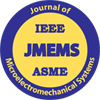
|
Journal of Microelectromechanical Systems | |||||
| Information for Authors | IEEE Xplore | ||||||
|
Editor-in-Chief: Christofer Hierold |
|
Administrative Assistant:
|
||
|
The Journal of Microelectromechanical systems (JMEMS) is published under the joint sponsorship of the Institute of Electrical and Electronic Engineers IEEE and the American Society of Mechanical Engineers ASME. Three societies of IEEE, Electron Devices, Industrial Electronics, and Robotics and Automation are direct sponsors of JMEMS and members of these societies may subscribe to the journal at favorable rates. The first issue of IEEE/JMEMS appeared in March, 1992 and the Journal was published quarterly from 1992 to 2002 when it changed to a bimonthly format. From 1992 to 1997, the JMEMS Editor-in-Chief was Dr. William Trimmer; in 1997 Professor Richard S. Muller of the University of California, Berkeley became EIC. On October 1, 2012, Professor Christofer Hierold at the Swiss Federal Institute of Technology in Zürich assumed the Journal leadership. The JMEMS Editorial Board plays a key role in assuring the archival quality of published papers. One of the Editorial Board members is responsible for the review process of each paper and that Editor is identified in a footnote on the first page of each accepted paper. Those members of the Editorial Board, who are designated as Senior Editor, are sometimes assigned the responsibilities of Editor-in-Chief for selected submitted papers to JMEMS. Each year, a list is published identifying reviewers (except for those who wish to remain anonymous) without reference to any particular paper. Roughly 3600 papers have been submitted to JMEMS through December of 2010 and acceptance rates have been in the range of 60% since the first issue. The publishing philosophy for JMEMS is embodied in the following statement. IEEE/ASME JMEMS publishes papers that describe advances in microelectromechanical systems (MEMS). Topics covered in JMEMS papers deal with micromechanics, microdynamical systems, microfabrication technologies useful for MEMS, modeling and design issues for MEMS, materials properties that bear on MEMS designs, phenomena pertinent to MEMS designs and performance, MEMS characterization and reliability, interface issues affecting mechanical, electrical, chemical, and biological factors associated with MEMS, tribology issues for small devices. Typical MEMS devices have smaller than mm dimensions and they are characterized by engineering and control of lengths and movements that range typically from nm to micrometers. Papers that are sometimes described as being concerned with nanotechnology are welcome in IEEE/ASME JMEMS, a journal in which the term "micro" is interpreted in its classical sense as "tiny." After pre-screening by the Editor-in-Chief (EIC), submissions to JMEMS are given at least two reviews by invited reviewers whose help is requested by an Editor selected in turn by the EIC. IEEE publication policy requires at least two reviews for submissions to its technical journals. If you,the reader, would like to offer service as a reviewer, please send email describing your interest and activities directly to an Editor whose interest area in the MEMS/NEMS field is closest to your own. These interest areas are most easily identified by accessing the Editor's web sites using the link to the Editorial Board cited above. Information for Authors - Submit Papers on the Web using SCHOLARONE ManuscriptsAuthors are invited to submit their papers to JMEMS using the web-based submission software of SCHOLARONE Manuscripts, uploading their manuscripts to the JMEMS SCHOLARONE Manuscripts Website . In order to login to the site, users need first to create an account (unless one already has been opened) by accessing a "create account" link that is found on the upper-right-hand side of the home page. Helpful user tutorials and specific system requirements are accessible in links to the "resources" section of the home page. All site users are eligible to upload papers to the website, and all users also are eligible for service as reviewers. When they create an account, users are required to list at least one keyword describing a personal interest area. Entering multiple keywords that show user breadth is encouraged to enable effective computer searches for users having particular interest areas. Step-by-step instructions guide authors through the procedures needed to enter their papers at the site. Once the papers have been entered, the JMEMS Site Administrator (ADMIN) will check that all requirements for manuscripts have been met and then will notify the Editor-in-Chief (EIC) who appoints a member of the JMEMS Editorial Board to serve as the paper Subject Editor (ED) and conduct a review of the paper. The ED appoints two or more reviewers who will evaluate the paper. These reviewers are carefully selected with respect to their interest areas and expertise as well as absence of any conflict-of-interest that might possibly affect the reviewing process. The identities of particular reviewers for any given paper are kept secret except for the ED, the EIC, and the ADMIN. At the end of each year, a list of reviewers is published to acknowledge their service (without, of course, making reference to the papers they have reviewed). Reviewers can, however, ask that they not be included on the acknowledgement list, but rather remain anonymous. While the paper is undergoing review, the ED will typically communicate with the authors one or more times to request revisions of the manuscript and then ask the reviewers for an evaluation of the revised paper. At some point in this interactive process, the ED decides either that the paper being reviewed is ready for publication or that it should be rejected. The ED conveys this recommendation, along with a summary of reviewer findings, to the author(s) and to the EIC. After review of the paper and inspection of the reviewing process, the EIC makes a final decision for publication or rejection and notifies the author(s). Accepted papers are transferred by the EIC to the Managing Editor in the transactions and publications division of IEEE (IEEE ME). The IEEE ME is responsible to see that the paper is in the proper form for publication and for addition to the digital database, IEEE Xplore. In this final stage, interactions between authors and the JMEMS staff are conducted with the IEEE Managing Editor. JMEMS will accept manuscripts for review either in a Letters format or in the traditional nominally eight-page length. JMEMS Letters are meant to encourage rapid publication of original and significant contributions that are limited in length (to three or fewer published pages), and appropriate for early dissemination. Specific guidelines for JMEMS Letters are described in a linked document JMEMS Letters. If a Letter submission is accepted after its review, it will be published within two months in a section of the Journal containing only Letters. Papers submitted may not have been published elsewhere nor be under consideration for publication except by JMEMS. Authors are required to reference all relevant prior work of significance to the paper including publications authored by themselves. To avoid plagiarism, submissions may be cross-checked by sophisticated computer routines. JMEMS encourages manuscript submissions that are based upon papers presented at technical conferences or that have been published as Letters provided that the submitted paper has been enhanced significantly when compared with any written version published in conference proceedings or as a Letter. A newly submitted paper must contain 50% or greater new and substantive material, and it must include the conference presentation or Letter as its first cited reference. In order to aid the review process, authors submitting papers based upon conference presentations or Letters must upload a copy of the conference paper or Letter as an appendix to a newly submitted paper. A typical accepted submission to JMEMS will contain: a brief and clear synopsis of the paper in an abstract; an introduction that establishes the context for the paper; a section that details results including a thorough discussion of these results; and a final section that states conclusions and implications from the results described in the paper. An important advantage to authors that has been made possible by digital storage of papers is the ability to submit supplemental material together with manuscripts. Examples are expansive data sets, macros that exploit the special display capabilities of computers, code software for data analysis and simulation as well as other enhancements that can help interested readers to appreciate and make use of the research described. Any available supplemental material is available to readers through a link placed adjacent to the IEEE Xplore entry for an accepted paper. A fuller discussion of supplemental materials and their importance is the subject of a JMEMS editorial 'Advancing Research and Increasing Citations for Your Paper' . Authors should confine the length of their published papers to eight or fewer pages. Consider carefully the contents and sizes of figures and tables and the necessity for including them. If your manuscript is likely to exceed 10 printed pages (typically 24 to 30 pages of double-spaced, typed copy), you will need to convince editors that this size is necessary. Keep in mind that your submission will be studied carefully by reviewers; help them to do this effectively by coupling figures with their captions, and by making clear the placement of figures in the text. Managing the affairs of JMEMS at IEEE is Staff Senior Editor Keith Edick (k dot edick at ieee dot org). The Transactions/Publications Office is at 445 Hoes Lane, Piscataway, NJ, 08855-1331. Accepted papers need to be supplied to this office in electronic form as described in the Author Digital Tool Box. Prior to publication, copyright for an accepted paper must be transferred to IEEE. After a paper has been accepted, the author can do this electronically by using a "Create ECF" button (ECF stands for "Electronic Copyright Form"), found next to the title of the paper at the author's MC site. JMEMS Emeritus Senior Editor Stephen D. Senturia has written an editorial "How to Avoid the Reviewer's Axe" concerning the review process that can be valuable reading for authors. IEEE XploreThe Journal of Microelectromechanical Systems is stored on the IEEE JMEMS Xplore website. Visitors to this site may view tables of contents and abstracts of all JMEMS published papers. Subscribers can download any of the stored papers on this site in Adobe Acrobat (pdf) format. Authors and Editors alike can find advice on Using Xplore to identify research and researchers working on related areas. |
||||
